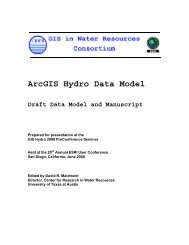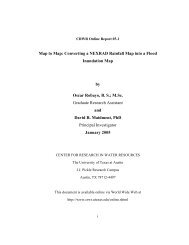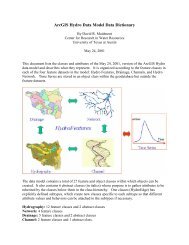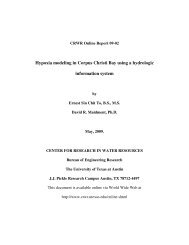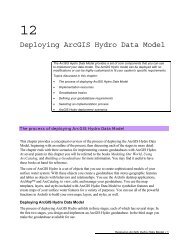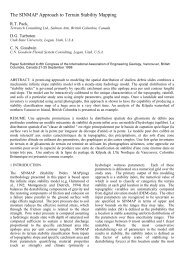View the Whole Report - Center for Research in Water Resources ...
View the Whole Report - Center for Research in Water Resources ...
View the Whole Report - Center for Research in Water Resources ...
You also want an ePaper? Increase the reach of your titles
YUMPU automatically turns print PDFs into web optimized ePapers that Google loves.
phenomenon is similar to sediment-laden runoff flow<strong>in</strong>g down a slope <strong>in</strong> <strong>the</strong> field at a<br />
high velocity. Sediment is deposited at <strong>the</strong> toe of <strong>the</strong> slope when <strong>the</strong> slope gradient and<br />
runoff velocity decrease.<br />
5.1.5 Description of Tested Controls<br />
The change <strong>in</strong> efficiency over time was observed by runn<strong>in</strong>g a series of tests<br />
through <strong>the</strong> same control. Four types of silt fences and a rock berm were subjected to<br />
cycles of simulated runoff events. The silt fences tested were constructed of geotextile<br />
fabrics. Properties of <strong>the</strong> fabrics as reported by <strong>the</strong> manufacturers are summarized <strong>in</strong><br />
Table 5.4.<br />
Table 5.4 Tested Silt Fence Fabric Properties<br />
Type of Fabric AOS, # sieve Permittivity, sec -1 No. of Tests<br />
size(µm)<br />
Belton woven #30 (600) 0.4 9<br />
Exxon woven #30 (600) 0.1 5<br />
Mirafi non-woven #100 (150) 1.5 5<br />
Amoco woven #20 (850) 0.2 5<br />
An attempt was made to determ<strong>in</strong>e <strong>the</strong> percent open area (POA) of <strong>the</strong> woven<br />
fabrics tested. The percent open area measures <strong>the</strong> percent of total fabric area that can<br />
pass water, while apparent open<strong>in</strong>g size measures <strong>the</strong> size of <strong>the</strong> open<strong>in</strong>gs. In<strong>for</strong>mation on<br />
<strong>the</strong>se characteristics would allow calculation of actual flow velocities through <strong>the</strong> fabrics.<br />
Specimens of all <strong>the</strong> woven silt fence fabrics were scanned and copied on a<br />
microfiche reader; however, only <strong>the</strong> Amoco 2125 fabric had well def<strong>in</strong>ed open<strong>in</strong>gs. The<br />
magnified pore open<strong>in</strong>gs were measured and <strong>the</strong> area of voids calculated. Three scans of<br />
<strong>the</strong> fabric were made on a bias across <strong>the</strong> specimen so that no one warp or weave would<br />
appear on ano<strong>the</strong>r scan. The average percent open area <strong>for</strong> three scans of that fabric was<br />
3.3%.<br />
A rock berm also was tested <strong>for</strong> sediment removal efficiency. TxDOT<br />
specifications were followed <strong>in</strong> <strong>the</strong> construction of a Type I unre<strong>in</strong><strong>for</strong>ced rock berm,<br />
41




